A humanitarian crisis is worsening at a refugee camp a short walk from the U.S.-Mexico border.
As many as 2,000 immigrants are waiting for U.S. court dates as medical and sanitary conditions deteriorate at the camp across the border from Brownsville, Texas, in the Mexican city of Matamoros.
Click to Gallery
In this Wednesday, Nov. 6, 2019, photo, Border Patrol agents apprehend a man thought to have entered the country illegally, near McAllen, Texas, along the U.S.-Mexico border. In the Rio Grande Valley, the southernmost point of Texas and historically the busiest section for border crossings, the U.S. Border Patrol is apprehending around 300 people daily. That’s down from as many as 2,000 people a day in May. (AP PhotoEric Gay)
In this Wednesday, Nov. 6, 2019, photo, Border Patrol agents apprehend a man thought to have entered the country illegally, near McAllen, Texas, along the U.S.-Mexico border. In the Rio Grande Valley, the southernmost point of Texas and historically the busiest section for border crossings, the U.S. Border Patrol is apprehending around 300 people daily. That’s down from as many as 2,000 people a day in May. (AP PhotoEric Gay)
In this Tuesday, Nov. 5, 2019, photo, migrant Justina holds her daughter, Samantha, at a refugee camp where she lives in Matamoros, Mexico. Shortly after they entered the U.S. to seek asylum in September, Justina and Samantha were taken to a type of Border Patrol station that migrants refer to as the “hielera,” or icebox. Samantha started having a fever and a cough. Eventually, her illness developed into pneumonia. (AP PhotoEric Gay)
In this Tuesday, Nov. 5, 2019, photo, Helen Perry, top, a nurse practitioner who serves as Global Response Management's operations director, attends to a migrant at a sidewalk clinic in a refugee camp in Matamoros, Mexico. The few doctors and nurses working in the camp are treating people including pregnant women and children with respiratory problems, skin conditions, diarrhea, and other diseases that can be linked to the camp’s unsanitary conditions. (AP PhotoEric Gay)
In this Tuesday, Nov. 5, 2019, photo, immigrants waiting for their U.S. court dates live in a refugee camp in Matamoros, Mexico, across from Brownsville, Texas, cooks dinner as the sun sets. The camp is an outgrowth of the Trump administration’s “Remain in Mexico” program, in which more than 55,000 migrants seeking entry into the U.S. have been ordered to pursue their cases outside its borders. (AP PhotoEric Gay)
A humanitarian crisis is worsening at a refugee camp a short walk from the U.S.-Mexico border.
They’re among those sent south of the border to wait and pursue their asylum cases under the Trump administration’s “Remain in Mexico” policy.
In this Wednesday, Nov. 6, 2019, photo, Border Patrol agents chase two men thought to have entered the country illegally, near McAllen, Texas, along the U.S.-Mexico border. (AP PhotoEric Gay)
In this Wednesday, Nov. 6, 2019, photo, Border Patrol agents apprehend a man thought to have entered the country illegally, near McAllen, Texas, along the U.S.-Mexico border. In the Rio Grande Valley, the southernmost point of Texas and historically the busiest section for border crossings, the U.S. Border Patrol is apprehending around 300 people daily. That’s down from as many as 2,000 people a day in May. (AP PhotoEric Gay)
In this Wednesday, Nov. 6, 2019, photo, Border Patrol agents apprehend a man thought to have entered the country illegally, near McAllen, Texas, along the U.S.-Mexico border. In the Rio Grande Valley, the southernmost point of Texas and historically the busiest section for border crossings, the U.S. Border Patrol is apprehending around 300 people daily. That’s down from as many as 2,000 people a day in May. (AP PhotoEric Gay)
In this Tuesday, Nov. 5, 2019, photo, a migrant walks through a refugee camp in Matamoros, Mexico. The camp is an outgrowth of the Trump administration’s “Remain in Mexico” program, in which more than 55,000 migrants seeking entry into the U.S. have been ordered to pursue their cases outside its borders. (AP PhotoEric Gay)
In this Tuesday, Nov. 5, 2019, photo, migrant Justina holds her daughter, Samantha, at a refugee camp where she lives in Matamoros, Mexico. Shortly after they entered the U.S. to seek asylum in September, Justina and Samantha were taken to a type of Border Patrol station that migrants refer to as the “hielera,” or icebox. Samantha started having a fever and a cough. Eventually, her illness developed into pneumonia. (AP PhotoEric Gay)
In this Tuesday, Nov. 5, 2019, photo, migrants live in a refugee camp in Matamoros, Mexico. The camp is an outgrowth of the Trump administration’s “Remain in Mexico” policy, in which more than 55,000 migrants have been told to wait and pursue their cases south of the border. (AP PhotoEric Gay)
In this Tuesday, Nov. 5, 2019, photo, fish caught in the Rio Grande are cooked in a refugee camp in Matamoros, Mexico. People regularly line up for a half-hour to fill up milk jugs and buckets with water. Some people bathe and wash their clothes in the Rio Grande, known to be contaminated with E. coli and other bacteria. They rely on donors who bring meals or pull fish from the river and fry them over wood fires at the camp. (AP PhotoEric Gay)
In this Wednesday, Nov. 6, 2019, migrants create a makeshift barbershop as they live in a refugee camp in Matamoros, Mexico. The camp is an outgrowth of the Trump administration’s “Remain in Mexico” policy, in which more than 55,000 migrants have been told to wait and pursue their cases south of the border. (AP PhotoEric Gay)
In this Wednesday, Nov. 6, 2019, migrants living in a refugee camp across from Brownsville, Texas, in Matamoros, Mexico, wash cloths in the Rio Grande. Some people bathe and wash their clothes in the Rio Grande, known to be contaminated with E. coli and other bacteria. (AP PhotoEric Gay)
In this Tuesday, Nov. 5, 2019, photo, migrants wait to receive medical care from a sidewalk clinic at refugee camp in Matamoros, Mexico. The few doctors and nurses working in the camp are treating people including pregnant women and children with respiratory problems, skin conditions, diarrhea, and other diseases that can be linked to the camp’s unsanitary conditions. (AP PhotoEric Gay)
In this Tuesday, Nov. 5, 2019, photo, migrants see a health care worker as they receive medical care at sidewalk clinic at refugee camp in Matamoros, Mexico. The few doctors and nurses working in the camp are treating people including pregnant women and children with respiratory problems, skin conditions, diarrhea, and other diseases that can be linked to the camp’s unsanitary conditions. (AP PhotoEric Gay)
In this Tuesday, Nov. 5, 2019, photo, a migrant child's tears are wiped away by her mother as they receive medical care at a sidewalk clinic in refugee camp in Matamoros, Mexico. The few doctors and nurses working in the camp are treating people including pregnant women and children with respiratory problems, skin conditions, diarrhea, and other diseases that can be linked to the camp’s unsanitary conditions. (AP PhotoEric Gay)
In this Tuesday, Nov. 5, 2019, photo, Helen Perry, top, a nurse practitioner who serves as Global Response Management's operations director, attends to a migrant at a sidewalk clinic in a refugee camp in Matamoros, Mexico. The few doctors and nurses working in the camp are treating people including pregnant women and children with respiratory problems, skin conditions, diarrhea, and other diseases that can be linked to the camp’s unsanitary conditions. (AP PhotoEric Gay)
In this Wednesday, Nov. 6, 2019, Dairon, a doctor from Cuba who is seeking asylum in the U.S. attends to fellow migrants at a sidewalk clinic in a refugee camp in Matamoros, Mexico. The few doctors and nurses working in the camp are treating people including pregnant women and children with respiratory problems, skin conditions, diarrhea, and other diseases that can be linked to the camp’s unsanitary conditions. (AP PhotoEric Gay)
In this Tuesday, Nov. 5, 2019, photo, a young boy plays soccer in a refugee camp in Matamoros, Mexico. The camp is an outgrowth of the Trump administration’s “Remain in Mexico” program, in which more than 55,000 migrants seeking entry into the U.S. have been ordered to pursue their cases outside its borders. (AP PhotoEric Gay)
In this Tuesday, Nov. 5, 2019, photo, immigrants waiting for their U.S. court dates live in a refugee camp in Matamoros, Mexico, across from Brownsville, Texas, cooks dinner as the sun sets. The camp is an outgrowth of the Trump administration’s “Remain in Mexico” program, in which more than 55,000 migrants seeking entry into the U.S. have been ordered to pursue their cases outside its borders. (AP PhotoEric Gay)
A smoke-filled stench lingers from ever-burning fires and piles of human waste. Drinking water is scarce. Families live in a sea of tents and tarps, some patched together with trash bags.
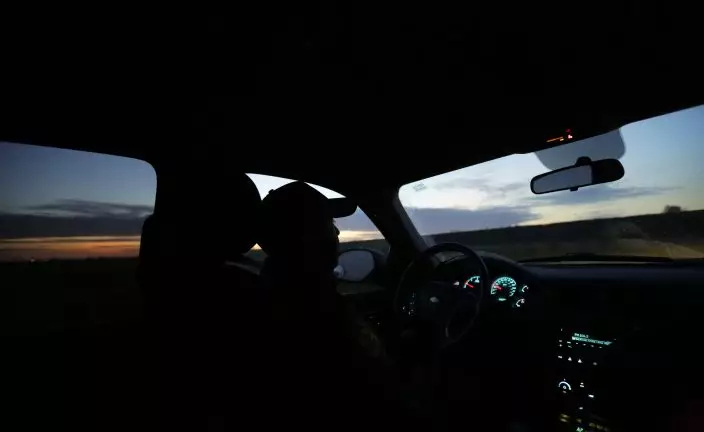
In this Wednesday, Nov. 6, 2019, photo, Border Patrol agent Hermann Rivera drives in McAllen, Texas, near the U.S.-Mexico border on a patrol searching for immigrants who have entered the country illegally. In the Rio Grande Valley, the southernmost point of Texas and historically the busiest section for border crossings, the U.S. Border Patrol is apprehending around 300 people daily. That’s down from as many as 2,000 people a day in May. (AP PhotoEric Gay)
They’re among those sent south of the border to wait and pursue their asylum cases under the Trump administration’s “Remain in Mexico” policy.
The conditions show the health risks associated with the policy and how nonprofits are struggling to provide basic services without more support from the U.S. or Mexican governments.
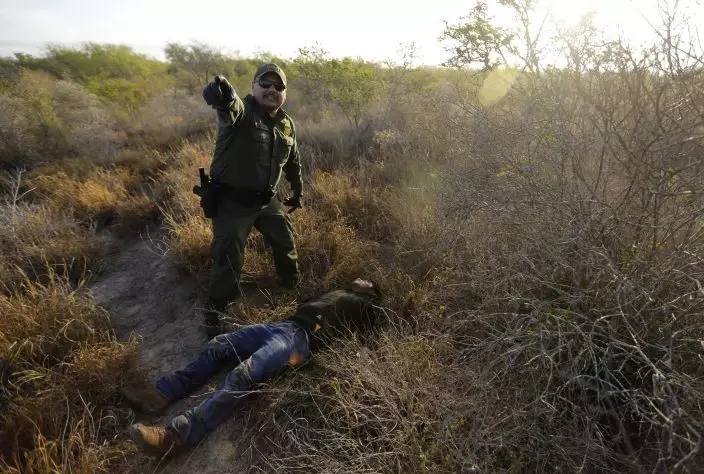
In this Wednesday, Nov. 6, 2019, photo, a Border Patrol agent gives directions to other agents after stopping a man thought to have entered the country illegally, near McAllen, Texas, along the U.S.-Mexico border. In the Rio Grande Valley, the southernmost point of Texas and historically the busiest section for border crossings, the U.S. Border Patrol is apprehending around 300 people daily. That’s down from as many as 2,000 people a day in May. (AP PhotoEric Gay)
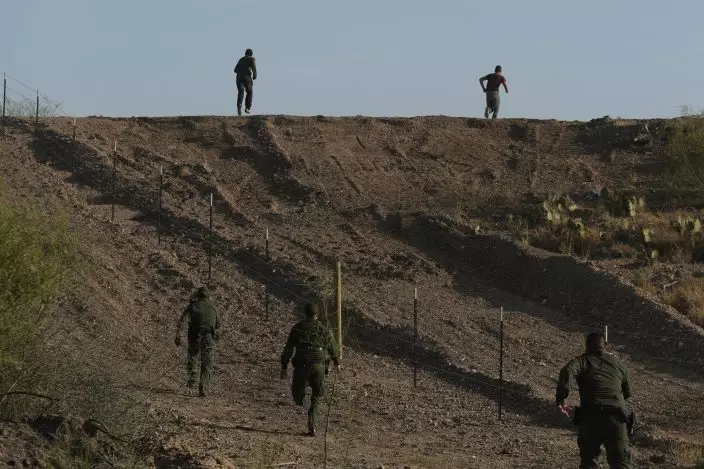
In this Wednesday, Nov. 6, 2019, photo, Border Patrol agents chase two men thought to have entered the country illegally, near McAllen, Texas, along the U.S.-Mexico border. (AP PhotoEric Gay)
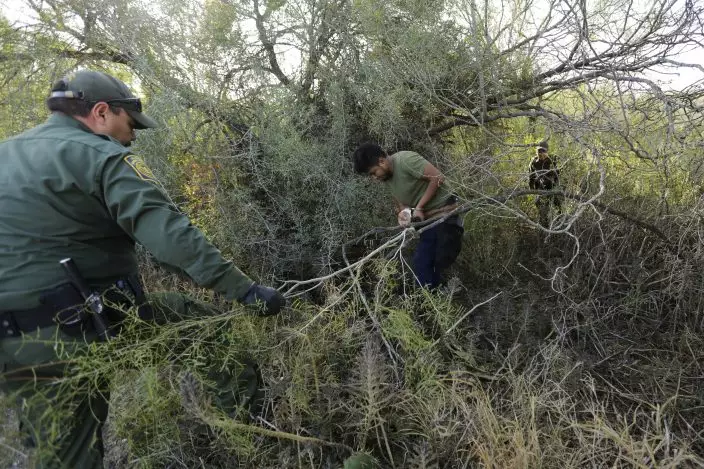
In this Wednesday, Nov. 6, 2019, photo, Border Patrol agents apprehend a man thought to have entered the country illegally, near McAllen, Texas, along the U.S.-Mexico border. In the Rio Grande Valley, the southernmost point of Texas and historically the busiest section for border crossings, the U.S. Border Patrol is apprehending around 300 people daily. That’s down from as many as 2,000 people a day in May. (AP PhotoEric Gay)

In this Wednesday, Nov. 6, 2019, photo, Border Patrol agents apprehend a man thought to have entered the country illegally, near McAllen, Texas, along the U.S.-Mexico border. In the Rio Grande Valley, the southernmost point of Texas and historically the busiest section for border crossings, the U.S. Border Patrol is apprehending around 300 people daily. That’s down from as many as 2,000 people a day in May. (AP PhotoEric Gay)
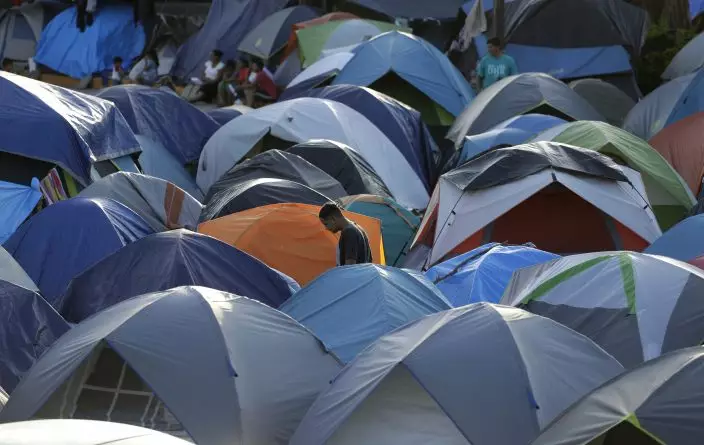
In this Tuesday, Nov. 5, 2019, photo, a migrant walks through a refugee camp in Matamoros, Mexico. The camp is an outgrowth of the Trump administration’s “Remain in Mexico” program, in which more than 55,000 migrants seeking entry into the U.S. have been ordered to pursue their cases outside its borders. (AP PhotoEric Gay)
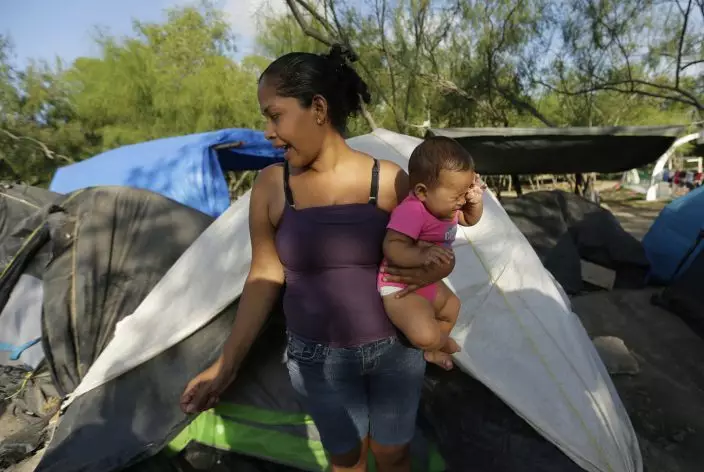
In this Tuesday, Nov. 5, 2019, photo, migrant Justina holds her daughter, Samantha, at a refugee camp where she lives in Matamoros, Mexico. Shortly after they entered the U.S. to seek asylum in September, Justina and Samantha were taken to a type of Border Patrol station that migrants refer to as the “hielera,” or icebox. Samantha started having a fever and a cough. Eventually, her illness developed into pneumonia. (AP PhotoEric Gay)

In this Tuesday, Nov. 5, 2019, photo, migrants live in a refugee camp in Matamoros, Mexico. The camp is an outgrowth of the Trump administration’s “Remain in Mexico” policy, in which more than 55,000 migrants have been told to wait and pursue their cases south of the border. (AP PhotoEric Gay)
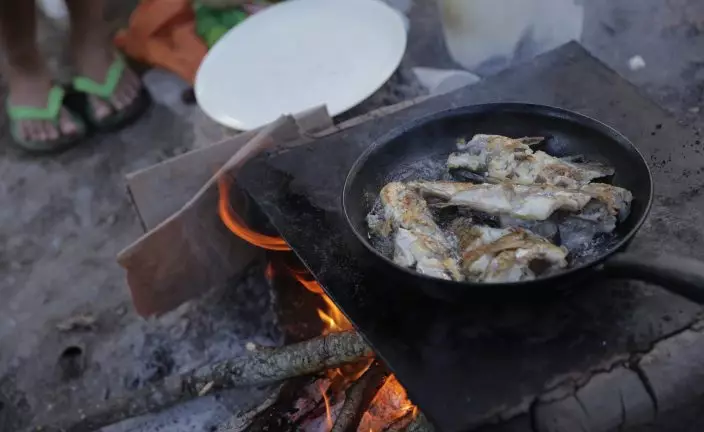
In this Tuesday, Nov. 5, 2019, photo, fish caught in the Rio Grande are cooked in a refugee camp in Matamoros, Mexico. People regularly line up for a half-hour to fill up milk jugs and buckets with water. Some people bathe and wash their clothes in the Rio Grande, known to be contaminated with E. coli and other bacteria. They rely on donors who bring meals or pull fish from the river and fry them over wood fires at the camp. (AP PhotoEric Gay)
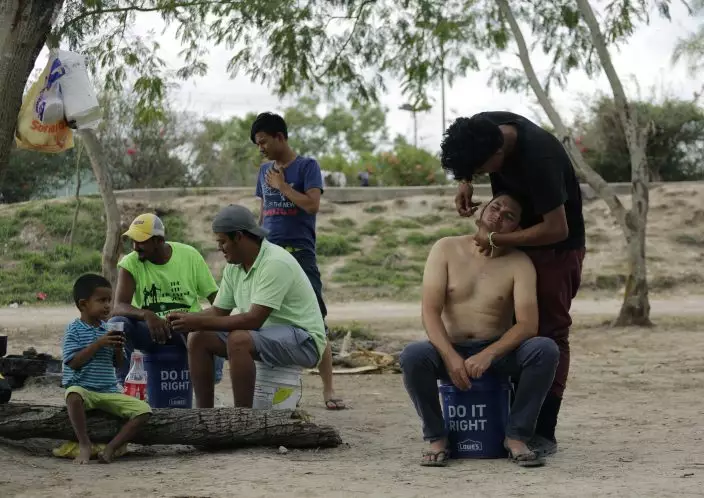
In this Wednesday, Nov. 6, 2019, migrants create a makeshift barbershop as they live in a refugee camp in Matamoros, Mexico. The camp is an outgrowth of the Trump administration’s “Remain in Mexico” policy, in which more than 55,000 migrants have been told to wait and pursue their cases south of the border. (AP PhotoEric Gay)
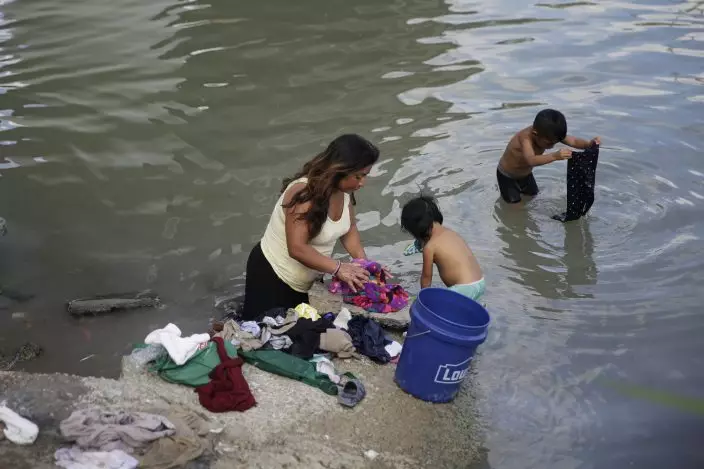
In this Wednesday, Nov. 6, 2019, migrants living in a refugee camp across from Brownsville, Texas, in Matamoros, Mexico, wash cloths in the Rio Grande. Some people bathe and wash their clothes in the Rio Grande, known to be contaminated with E. coli and other bacteria. (AP PhotoEric Gay)
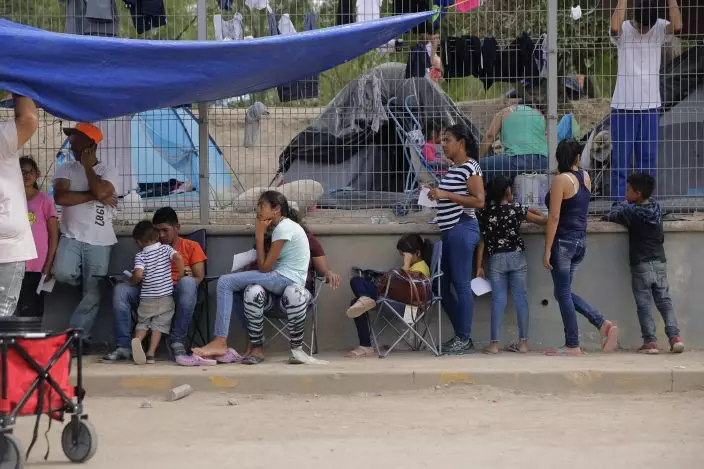
In this Tuesday, Nov. 5, 2019, photo, migrants wait to receive medical care from a sidewalk clinic at refugee camp in Matamoros, Mexico. The few doctors and nurses working in the camp are treating people including pregnant women and children with respiratory problems, skin conditions, diarrhea, and other diseases that can be linked to the camp’s unsanitary conditions. (AP PhotoEric Gay)

In this Tuesday, Nov. 5, 2019, photo, migrants see a health care worker as they receive medical care at sidewalk clinic at refugee camp in Matamoros, Mexico. The few doctors and nurses working in the camp are treating people including pregnant women and children with respiratory problems, skin conditions, diarrhea, and other diseases that can be linked to the camp’s unsanitary conditions. (AP PhotoEric Gay)
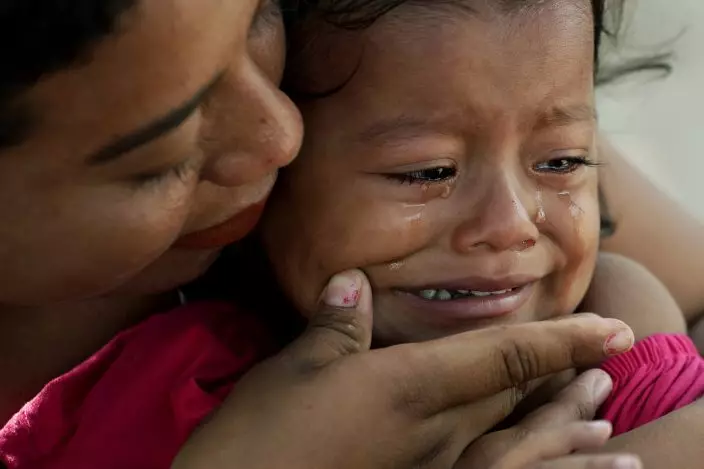
In this Tuesday, Nov. 5, 2019, photo, a migrant child's tears are wiped away by her mother as they receive medical care at a sidewalk clinic in refugee camp in Matamoros, Mexico. The few doctors and nurses working in the camp are treating people including pregnant women and children with respiratory problems, skin conditions, diarrhea, and other diseases that can be linked to the camp’s unsanitary conditions. (AP PhotoEric Gay)
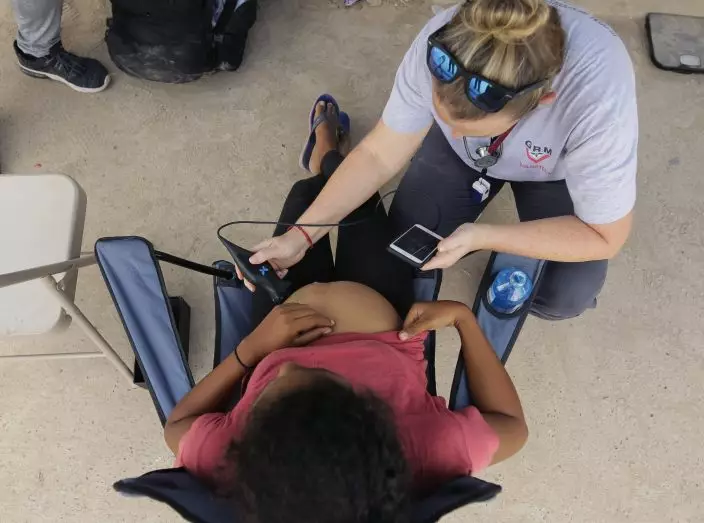
In this Tuesday, Nov. 5, 2019, photo, Helen Perry, top, a nurse practitioner who serves as Global Response Management's operations director, attends to a migrant at a sidewalk clinic in a refugee camp in Matamoros, Mexico. The few doctors and nurses working in the camp are treating people including pregnant women and children with respiratory problems, skin conditions, diarrhea, and other diseases that can be linked to the camp’s unsanitary conditions. (AP PhotoEric Gay)
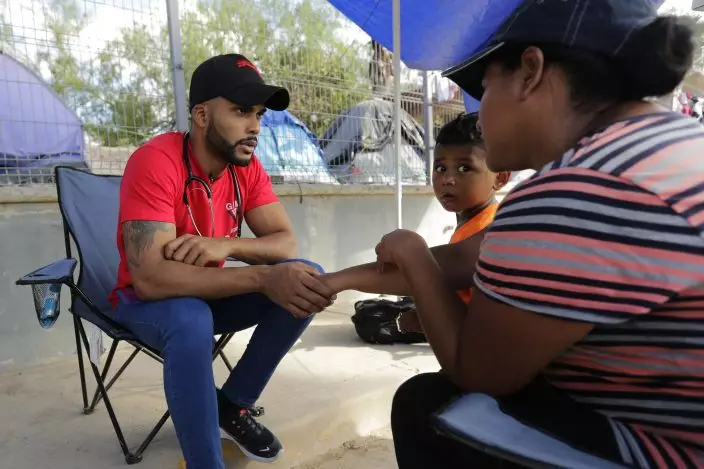
In this Wednesday, Nov. 6, 2019, Dairon, a doctor from Cuba who is seeking asylum in the U.S. attends to fellow migrants at a sidewalk clinic in a refugee camp in Matamoros, Mexico. The few doctors and nurses working in the camp are treating people including pregnant women and children with respiratory problems, skin conditions, diarrhea, and other diseases that can be linked to the camp’s unsanitary conditions. (AP PhotoEric Gay)

In this Tuesday, Nov. 5, 2019, photo, a young boy plays soccer in a refugee camp in Matamoros, Mexico. The camp is an outgrowth of the Trump administration’s “Remain in Mexico” program, in which more than 55,000 migrants seeking entry into the U.S. have been ordered to pursue their cases outside its borders. (AP PhotoEric Gay)
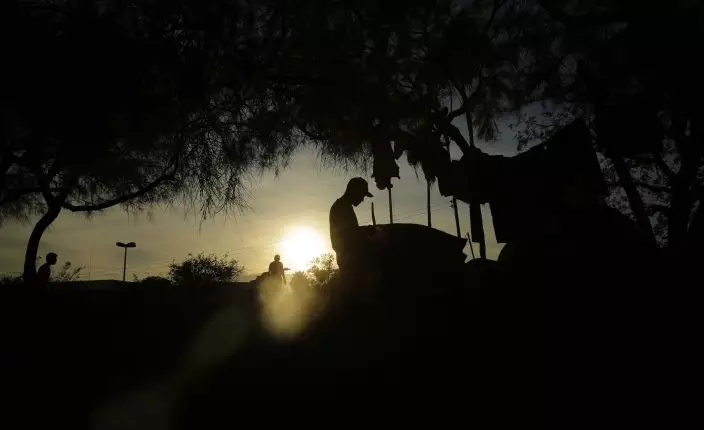
In this Tuesday, Nov. 5, 2019, photo, immigrants waiting for their U.S. court dates live in a refugee camp in Matamoros, Mexico, across from Brownsville, Texas, cooks dinner as the sun sets. The camp is an outgrowth of the Trump administration’s “Remain in Mexico” program, in which more than 55,000 migrants seeking entry into the U.S. have been ordered to pursue their cases outside its borders. (AP PhotoEric Gay)




















